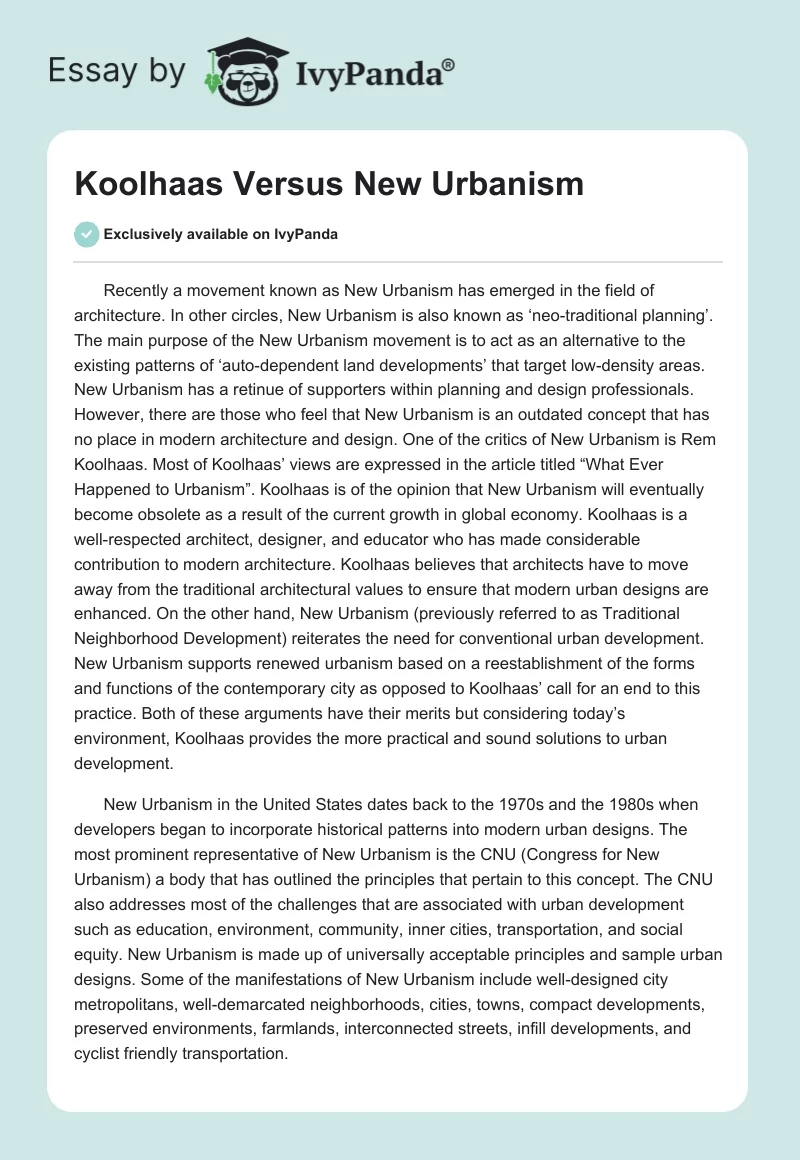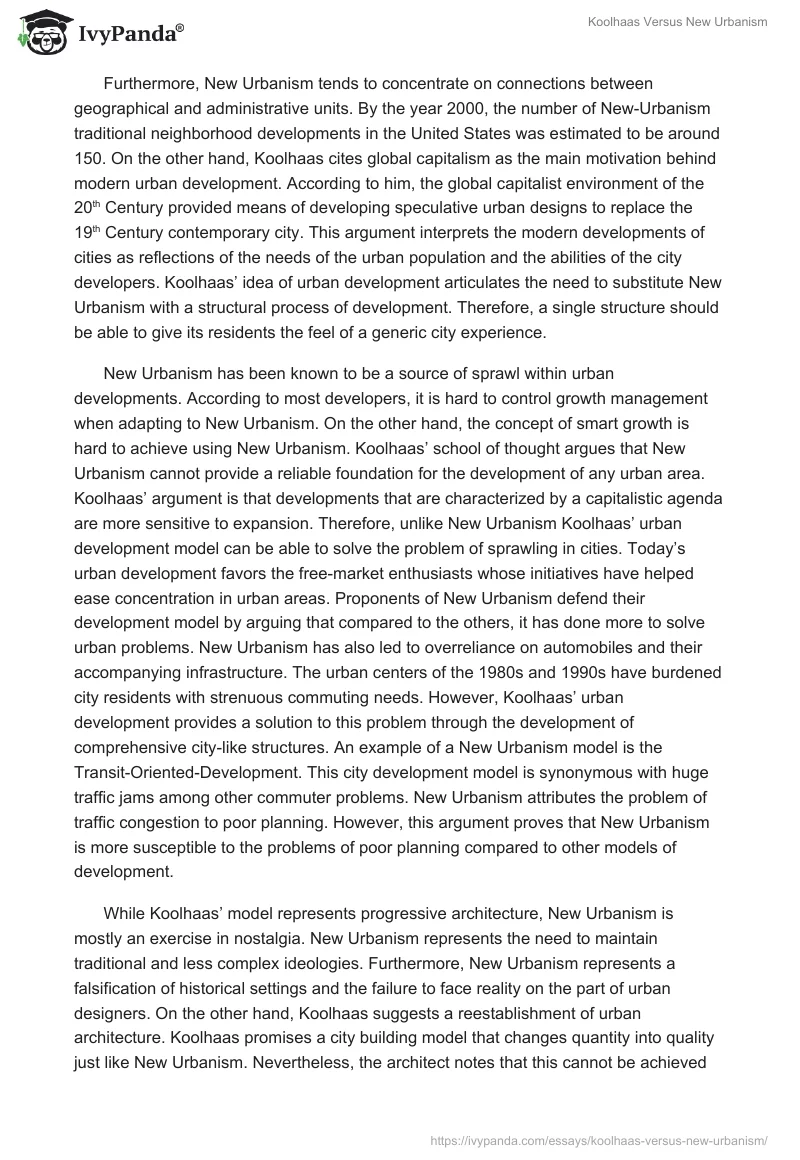Recently a movement known as New Urbanism has emerged in the field of architecture. In other circles, New Urbanism is also known as ‘neo-traditional planning’. The main purpose of the New Urbanism movement is to act as an alternative to the existing patterns of ‘auto-dependent land developments’ that target low-density areas. New Urbanism has a retinue of supporters within planning and design professionals. However, there are those who feel that New Urbanism is an outdated concept that has no place in modern architecture and design. One of the critics of New Urbanism is Rem Koolhaas. Most of Koolhaas’ views are expressed in the article titled “What Ever Happened to Urbanism”. Koolhaas is of the opinion that New Urbanism will eventually become obsolete as a result of the current growth in global economy. Koolhaas is a well-respected architect, designer, and educator who has made considerable contribution to modern architecture. Koolhaas believes that architects have to move away from the traditional architectural values to ensure that modern urban designs are enhanced. On the other hand, New Urbanism (previously referred to as Traditional Neighborhood Development) reiterates the need for conventional urban development. New Urbanism supports renewed urbanism based on a reestablishment of the forms and functions of the contemporary city as opposed to Koolhaas’ call for an end to this practice. Both of these arguments have their merits but considering today’s environment, Koolhaas provides the more practical and sound solutions to urban development.
New Urbanism in the United States dates back to the 1970s and the 1980s when developers began to incorporate historical patterns into modern urban designs. The most prominent representative of New Urbanism is the CNU (Congress for New Urbanism) a body that has outlined the principles that pertain to this concept. The CNU also addresses most of the challenges that are associated with urban development such as education, environment, community, inner cities, transportation, and social equity. New Urbanism is made up of universally acceptable principles and sample urban designs. Some of the manifestations of New Urbanism include well-designed city metropolitans, well-demarcated neighborhoods, cities, towns, compact developments, preserved environments, farmlands, interconnected streets, infill developments, and cyclist friendly transportation.
Furthermore, New Urbanism tends to concentrate on connections between geographical and administrative units. By the year 2000, the number of New-Urbanism traditional neighborhood developments in the United States was estimated to be around 150. On the other hand, Koolhaas cites global capitalism as the main motivation behind modern urban development. According to him, the global capitalist environment of the 20th Century provided means of developing speculative urban designs to replace the 19th Century contemporary city. This argument interprets the modern developments of cities as reflections of the needs of the urban population and the abilities of the city developers. Koolhaas’ idea of urban development articulates the need to substitute New Urbanism with a structural process of development. Therefore, a single structure should be able to give its residents the feel of a generic city experience.
New Urbanism has been known to be a source of sprawl within urban developments. According to most developers, it is hard to control growth management when adapting to New Urbanism. On the other hand, the concept of smart growth is hard to achieve using New Urbanism. Koolhaas’ school of thought argues that New Urbanism cannot provide a reliable foundation for the development of any urban area. Koolhaas’ argument is that developments that are characterized by a capitalistic agenda are more sensitive to expansion. Therefore, unlike New Urbanism Koolhaas’ urban development model can be able to solve the problem of sprawling in cities. Today’s urban development favors the free-market enthusiasts whose initiatives have helped ease concentration in urban areas. Proponents of New Urbanism defend their development model by arguing that compared to the others, it has done more to solve urban problems. New Urbanism has also led to overreliance on automobiles and their accompanying infrastructure. The urban centers of the 1980s and 1990s have burdened city residents with strenuous commuting needs. However, Koolhaas’ urban development provides a solution to this problem through the development of comprehensive city-like structures. An example of a New Urbanism model is the Transit-Oriented-Development. This city development model is synonymous with huge traffic jams among other commuter problems. New Urbanism attributes the problem of traffic congestion to poor planning. However, this argument proves that New Urbanism is more susceptible to the problems of poor planning compared to other models of development.
While Koolhaas’ model represents progressive architecture, New Urbanism is mostly an exercise in nostalgia. New Urbanism represents the need to maintain traditional and less complex ideologies. Furthermore, New Urbanism represents a falsification of historical settings and the failure to face reality on the part of urban designers. On the other hand, Koolhaas suggests a reestablishment of urban architecture. Koolhaas promises a city building model that changes quantity into quality just like New Urbanism. Nevertheless, the architect notes that this cannot be achieved through repetition and abstraction. New Urbanism has relied on familiar aesthetics, ideas, and strategies to transform cities but this has not worked. Koolhaas also notes that while architects are ready to switch to newer and practical models of urban development, other city planning stakeholders are determined to maintain the status quo. Proponents of New Urbanism maintain that their model of development is applicable to all levels of city development. However, this argument is nullified by the constant shortages that dominate modern urban centers. The alternative to New Urbanism follows a strict path of capitalism where city development goes hand-in-hand with the needs of the population. On the other hand, New Urbanism is constantly battling undersupply and in rare cases oversupply of city resources. From Beijing to Lagos, cities all over the world are battling problems of inadequacy in infrastructure and resources, which are all related to New Urbanism.
Another shortcoming of New Urbanism is that it tends to ignore the needs and realities of the modern world. The modern world is dominated by economic and social realities that New Urbanism has been unable to solve. Some of these realities include cheap energy, computer networks, and a globalized economy. These realities are continuously rendering the city-building concept irrelevant. Furthermore, residents prefer individuality and privacy to community settings. Residents also tend to favor sparsely populated areas over the congested city environment. Koolhaas’ model considers and tries to align itself with these realities. For instance, some urban centers have become completely undesirable after some popular ‘New Urbanism’ additions. For example, the construction of Crawford Square in Pittsburg, Pennsylvania increased the hardships of the Hill District considerably.
Both Koolhaas and proponents of New Urbanism highlight pertinent matters in their arguments. However, the reign of New Urbanism has come an end due to the advent of globalization. Koolhaas provides a city development model with a sound solution to the problem of sprawling in modern cities. This model is also in terms with the realities of modern city development.


